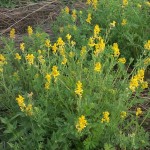Golden Corydalis
Corydalis aurea
Fumariaceae
Description
Golden corydalis is a spreading, yellow-flowered member of the poppy family. It is sometimes referred to as scrambled eggs. Its stems are pale or whitish and leafy. The leaves have numerous small segments. The yellow flowers, irregularly shaped and spurred at the base, occur from February to May. They appear in loose clusters at the ends of the branches. The seeds are black and shiny.
Habitat
The plant is distributed widely in the western half and central parts of Texas. It is also found north to South Dakota, west to Utah and in southern Nevada and Arizona. Golden corydalis often grows in disturbed areas, along stream banks, in open woods and in sandy soils throughout Texas.
Toxic Agent
This plant reportedly contains up to 10 alkaloids. Sheep like this plant, and eating as little as 2 percent of their weight can cause clinical signs. Less than 5 percent can be fatal. Although this plant reportedly poisons cattle and horses, they generally are much more resistant than sheep. Goats are least susceptible, cattle intermediate, and sheep are most susceptible. Livestock losses from this plant are much lower in Texas than in other states, such as Arizona.
Signs of Livestock Ingestion
Cattle and sheep clinical signs are similar and often appear within minutes and usually within a few hours of consuming corydalis. They include: Uneasiness; Twitching facial muscles; Rapid respiration; Staggering and falling into convulsions.
Downed animals make running motions with their feet. Diarrhea and bleating or bawling are common. Throughout the period of clinical signs, the animals bite at nearby objects. Affected animals usually experience several cycles of these fits, between which they exhibit normal behavior. In lethal cases, breathing and heart action slow, and after successive convulsive periods, the animal dies. Animals not lethally poisoned usually recover quickly and uneventfully.
Management Strategies
Golden corydalis has not been a serious problem in Texas. Range management practices promoting improved range condition help reduce losses to this plant. Proper supplemental feeding programs also help. For extreme populations, graze infested pastures with livestock least susceptible to corydalis poisoning.
Images
Plant Characteristics
Flower Color: Yellow
Seed Type: Bean/Pod
Duration: Perennial
Stem Texture: Hairy
Growth Habit: Forbs/Broadleaf
Leaf Shape
 : Pinnately Compound
: Pinnately Compound
Season: Warm
Distribution
 : 05 - Cross Timbers and Prairies, 07 - Edwards Plateau, 08 - Rolling Plains, 09 - High Plains, 10 - Trans-Pecos
: 05 - Cross Timbers and Prairies, 07 - Edwards Plateau, 08 - Rolling Plains, 09 - High Plains, 10 - Trans-Pecos
Distributions
Distribution refers to the ecological region in Texas that a plant has been found. You can also view a clickable map.
Book: Toxic Plants of Texas (B-6105)
Collection: Toxics, Wild Flowers
Livestock Affected: Cattle, Horses, Sheep
Livestock Signs: Convulsions, Diarrhea, Excitability, Incoordination, Irregular Breathing







